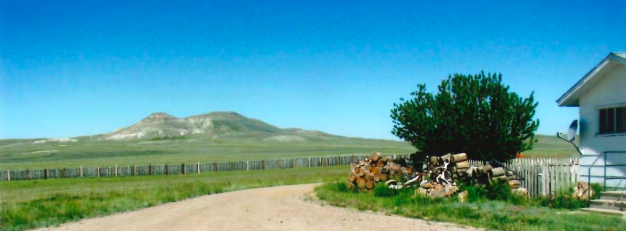
“Boot Heel” west of the Homestead.
The history of the George & Augusta Smith “Cross Reversed 4” Homestead & the Nat Smith / Newkirk “Arrowtail” Ranch in northern Albany County Wyoming (WY) began in Council Bluffs, Iowa, where George E. Smith was born May 25, 1888, and Augusta M. Henggeler was born January 4, 1893. Dad’s family was of English & Irish descent–he was the oldest of four children. Mother’s family, the Joseph Henggelers, was of German descent and she was third youngest of nine children. On February 20, 1917, George & Augusta were married in Curtis, Nebraska (NE), and farmed near Stockville, NE with his Dad. Their first child Nat Edward, was born in Curtis on July 1, 1918.
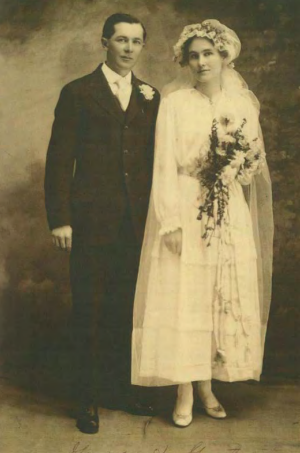
George and Augusta Smith on their wedding day on February 20, 1917 in
Curtis, Nebraska.
In the spring of 1919, with a year-old baby and another shortly on the way, they came to WY looking for land–free for the homesteading. Since no one had farmed this part of WY, George assumed it would be much like in NE. The land they legally filed on (Section 14; Township 26 North, Range 76 West) was approximately 35-miles northeast of Medicine Bow and 40-miles north of Rock River, near the landmark hill of “Boot Heel”. They returned to Curtis, NE to winter, and 2 weeks later Florence Elizabeth was born September 17! “Mother was a most courageous woman to make a trip like that so close to giving birth.”
In the spring of 1920, Dad returned to WY in an immigrant car on the Union Pacific Railroad with all their belongings–cows, horses, machinery, furniture, chickens, etc. Unloading in Medicine Bow (“the Bow”), he hitched his team to the wagon filled with all it would hold and went to the homestead. The “overflow” was left in the Bow, confident it would still be there later, since honesty and trust were the standard back then–a man’s word was good and a handshake sealed a bargain. “How far we have strayed!” While living out of a tent, Dad built the first 8 X 10 foot cabin from West Coast Fir purchased in the Bow. With a dirt floor, 2 small windows, table, chairs, bed, a small woodstove, he also added an overhead hammock for the kids to sleep in.
Groundwater for the house, garden, and livestock were scarce, so Dad punched a well, using a cable system to lift and drop the handmade bit (perhaps like a “Drive Point” bit), hitting a good source approximately 80 feet deep. Then he installed a hand pump (“I guess you could say we had running water – someone always had to run and get it!”). He later put up a windmill. In the late summer of 1920, with the cabin finished (and still standing today) Dad sent for his family and Mom, Nat and Florence arrived by train. This was the beginning of the new adventure, never dreaming of the struggle that life on the barren plains of WY would bring.
Due to cold, severe winters, the family couldn’t spend the first few of them in their cabin, so they took their livestock and spent them at a neighbor’s place, about 10 miles north, near the Marshall Post Office. Dad helped care for the livestock and did other chores. Mother kept the house and did the cooking.
As time went on, it became apparent farming in WY wasn’t like in NE, with the only water–from Mother Nature–the critical element. Dad worked long, hard hours to break up the land and plant crops–small grains initially (rye, clover). Later, potatoes did very well–more than enough for the family, so he took the rest to the Bow and sold them to help pay the grocery bill. Along with other “Mom” duties, she always raised a big garden.
During the first several years, there were trips back to NE doctors for Nat, since his right arm was injured at birth and didn’t develop properly. It was put in a cast raised above his head and later in a metal brace. Mother removed the brace several hours each day, and massaged the muscles and nerves with a battery operated vibrator. His arm did grow and develop, though somewhat smaller and shorter than his left. But it was never a handicap–he used it for everything.
Our family continued to grow. Mae Helen was born Sept 11, 1923, so in 1924 Dad built not only a larger house using rough lumber from a nearby saw mill, but also a small cabin for the school house. A district school was established for Nat (6) and Florence (5). The teacher lived with us and paid $20 a month for room and board. Katherine Augusta (Kay) was born Sept 12, 1926, and Anita Margaret – a winter baby – was born Jan 11, 1929 in Laramie. The rest of us were born at the homestead with Dr. Cell from Medicine Bow attending–provided he got there in time! By 1930, they needed a bigger house, so we moved an existing one from another homestead south of us and joined the two together. In the fall of 1931, Dad went to the Bow and bought our annual winter supplies, livestock feed, new shoes for Mae and Kay, and a 5-gallon can of gas. On the way home, the truck caught fire. He tried putting it out with snow, but had to back away and watch it burn, then walked approximately 12 miles home in the dark. The next morning as he told us all, tears came to his eyes– the only time we ever saw our Dad cry. He rebuilt the truck later and used it for several years. On Nov 2, 1931, Fred Joseph Smith joined the family. In 1932, Dad made plans to build a nice log barn, and eventually did with the help of neighbors.
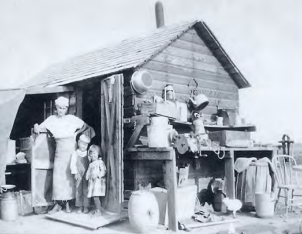
The first homestead cabin George built in the summer of 1920. The
picture was taken in 1923. (L-R) Augusta (30), Nat (5), and
Florence (4).
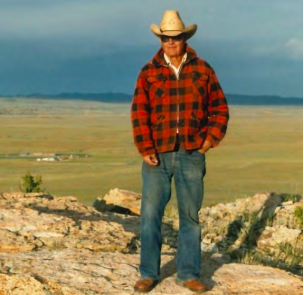
Nat Smith standing on top of “Boot Heel” with ranch buildings in the
background (n.d.).
The depression was hard, and many homesteaders “gave up” and moved away. But we thankfully made it through due to a good dose of perseverance, working hard, and our family made many social friends as we attended neighborhood dances, school programs, 4-H activities, community picnics, and, weather permitting, Easter Sunday church was in Hanna approximately 50-miles west, a long trip in the back of the old truck!
Winter of 1936, the family experienced a double tragedy. In December, my Dad was called back to Curtis, NE as his father was very ill (injured by a tornado May of 1935). Dad went by train, sick himself from that cold winter from helping build the LaBonte Canyon Albany County road to Douglas with horses, slips and Fresnos. Shortly after arriving in Curtis, Dad developed pneumonia, his condition worsened, and just after Christmas Mom was telegrammed to come to NE. So she took the train, leaving us 6 kids home alone. Regrettably, on December 29, our Grandpa Fred Smith passed away, and two days later on December 31, our Dad, George (48) died. On New Year’s Day 1937, Dick Cooper, Chevy dealer in the Bow, delivered another telegram stating we all needed to go to NE for the funerals. So Nat immediately found a neighbor to stay and care for our place, Florence gathered things for the trip, then Dick took the 6 of us back to the Bow, and put us on the train to North Platte (he bought our tickets, later reimbursed by Mom). Both funerals were held in Curtis, a couple days apart. Shortly thereafter, Mom’s brother John Henggeler brought Mom and the 6 of us back to WY in the nice car Grandma Smith gave us–a 1936 Ford they’d only owned for a short time. We were so grateful and fortunate to have it.
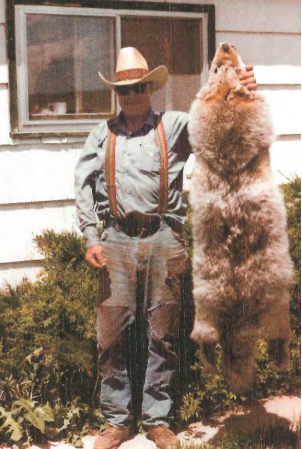
Nat with a “Super Coyote”.
What did the future now hold for us as we settled in without Dad in the place he had so proudly acquired only 16 years before, worked so hard to keep, constantly improved and raised his family? Mom was almost 44, Nat-18, Florence-17, Mae14, Kay-10, Anita-almost 8, and Fred-5. We stayed the rest of that winter helping Mom and continued our schooling. That fall, Nat married Marion “Rae” Rinearson on November 13, and took over running the ranch. Mom took us 5 remaining kids to Laramie, working any job available, determined to keep our family together. We all went back out to the ranch the next summer, and that Fall (1938), Mom turned the ranch over to Nat. Mom had purchased the section just west, homesteaded by George’s sister- -the Battelle’s, for a tax title, and included a nice livable house.
Nat and Rae had 4 children: twins Margaret Ann & Marie Elizabeth were born January 7, 1939; Daniel Edward on December 4, 1940, and Donna Lee on March 14, 1942. They were all raised on the ranch. At one time, the kids had a bobcat they raised from a kitten. If Nat had trouble getting the kids up in the morning, all he had to do was open the bedroom door and the bobcat did the rest!
Rae was a certified teacher so the school district reestablished the school and she taught all of them through the 8th grade. Nat raised both cattle and sheep. He devoted his life to the ranch, but was a good neighbor, and made many friends all over the country. He always enjoyed the Fall antelope hunters, and vice versa. For several years he sold Goose Neck trailers, and made many friends in Texas where he bought them. He loved to tell stories and incidents of rural life [e.g., “At a family gathering, all the kids wanted to ride a horse. ‘Old Strippy’ (she had a white stripe down her nose) was saddled, then facetiously Nat said to us (Florence, Mae, Kay) loud enough for the kids to also hear, ‘you’d better put one up there first who you don’t care much about because I don’t know how she will act with kids.’”]
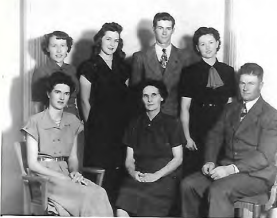
(Standing L-R) Mae, Anita, Fred, Kay. (Seated L-R) Florence, Augusta, Nat.
Picture taken in 1948.
Over the years Nat went into the sheep business almost entirely. He had acquired more available land, and it was most suitable to sheep. Besides Nat’s busy and dedicated ranch work, in August 1949, he received the contract to be the rural mail carrier for the Marshall route. It was a twice-a-week ~85 mile round-trip on dirt roads to transport mail sacks back and forth between area ranches and the Medicine Bow Post Office. (In 1974, the U.S. Postal Service awarded him for 25 years of accident-free driving, and 20 years of never missing a day of service, records he continued nearly unblemished for more than 50 years, despite major winter snow storms. Not many folks in their 80s could claim that honor!) As he travelled those roads, he was always on the lookout for the primary predator of his sheep–the abundant coyotes. They could kill or maim a number of herd sheep in short order, seriously impacting his family’s livelihood; thus, he dispatched them when he could, selling the winter hides.
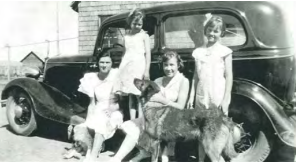
(L-R) Florence, Anita, Mae, and Kay.
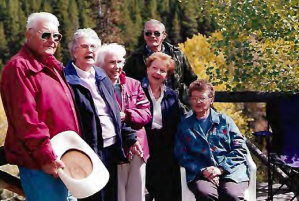
(L-R) Nat, Florence, Mae, Anita, Fred, Kay
In 1952, Rural Electric Association crews built electrical services to all the local ranches. What a blessing – refrigerators, deep freezers, dishwashers, radios, automatic washers and dryers, television, electric lights in the home and out buildings – these were some of the pleasures these hardy folks had lived without. And with only local “hoot ‘n holler” telephones, the two-way business band radios were a great invention, used by many ranchers, both in homes and vehicles (precursors of cell phones!).
In 1961, Nat and Rae were divorced and a couple of years later in 1963, he married Kathleen (Kitty) McCoy. She had a son Eric Thompson who joined them on the ranch. Kitty raised and trained Arabian horses. (She passed away in 1991).
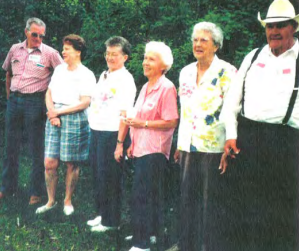
(L-R) Fred, Anita, Kay, Mae, Florence, Nat. Picture taken in 1998.
By 1978, Nat’s children had married and moved away. His youngest daughter Donna and husband Ernest Newkirk moved from McFadden and bought a place just north of Rock River. They had three boys, Robby, Ronny, and Roger. The two places were only about 40 miles apart, so they spent many days helping at both places doing the necessary ranch work–a welcome arrangement to meet Nat’s need for extra help in his later years. Regrettably, Ernie (42) passed away from leukemia in 1983, but Donna, Roger and his family stayed at the Rock River ranch and continued using both places for their ranching operations. Nat remained on the homestead, managing the day-to-day work of caring for the sheep well into his eighties. “…(Nat) gave up horses for 4-wheelers…’they always stand where you leave them…and you don’t have to feed them when they’re not working.” Roger and wife Tammy purchased most of his sheep, and gradually took over their management, with sage advice from Nat. They were also awarded the Marshall mail route job. Nat and Ellen Smith were married in 1993, and remained on the ranch until health issues precluded it.
In 2004, Donna Newkirk received the Albany County “Ranch Woman of the Year” award. Not only had she continued to help Nat with the livestock, haying, etc., she kept up with her grandkids 4-H projects and school activities. And since 1978, she was the Rural Mail Carrier for the northern Albany County Garrett community, also a twice-weekly, approximately 130- mile round trip on dirt roads in all kinds of weather. On July 1, 2008 Nat celebrated 90 years enjoying the ranch life he lived. On New Year’s Day, 2009 while staying with Donna in Rock River, he suffered a stroke, then passed away in Laramie on February 17, 2009.
The George Smith homestead can claim 5 generations. Although George, Augusta and Nat are gone, Donna, son Roger, Tammy and their 2 girls, Cassidy and Jacie, continue to ranch on the land George and Augusta originally homesteaded 100-years ago. However, Roger regrettably reports they’ve had to get out of the sheep business after 75 years due to predator losses to coyotes, eagles, ravens and bobcats. Instead, the family now runs a cow-calf operation, and summer about 200 head of cattle on the original homestead. They keep about 200 over the winter on hay meadows just outside of Rock River.
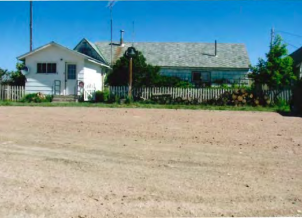
Original house George Smith built (1920) for his wife and two children.
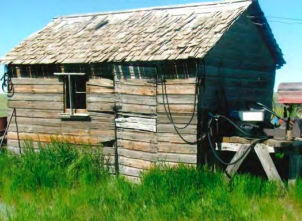
Nat and Rae Smith’s house started out as a two-room homestead cabin. Nat added on to it as the family grew to four children.
As for the rest of Nat and Rae’s family: Marie and Charles Atkinson had 2 girls–Laurie, Barbara; Margaret and Don Williams had 4 kids–Robert, Dean, Sharon, Rochelle; Dan & Dollie (Stacy) Smith had 2–Kim, Dannette; later Dan married Charlene Anderson, with her son Charles.
As for our Mom–Augusta–and the rest of us 5 kids, Dad had left a small insurance policy that was used to pay bills and his funeral expenses. In the fall of 1938 after Nat took over the homestead, mother took us to Laramie–her frugal ways continued. At first, she received some help financially from the School District and Social Services, but she was never comfortable to be on welfare. She always had a job–cleaned houses, worked in the stockroom at Woolworths, took in washing and ironing, was a motel maid, cooked at the hospital, and one winter took care of a small handicapped child. None of these brought in much money, but she was determined to keep the family together. As us girls and Fred grew older, we all worked in any job available for teenagers and helped out in any way we could. We all graduated from high school and some went to college. Life for Mother became less demanding, but she continued her independence, and simple way of life–ironing clothes up until the time she was no longer able. The love and pride she instilled in all of us as a family, is hopefully a credit to her hard work and dedication.
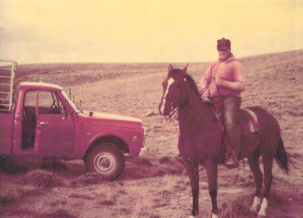
Nat Smith.
Several years before Mom died, she expressed a desire to move our Dad’s remains from Curtis, NE to Laramie. In 1980, she purchased a double plot at the Laramie Greenhill Cemetery, where he now rests. On July 2, 1981 Mother passed away at 88, now laid to rest forevermore back together beside our Dad. And all of us married and stayed in WY (except Fred) and raised our families, always remembering with profound respect and gratitude the hardships they endured and the sacrifices Mom and Dad made for all of us! God rest their souls.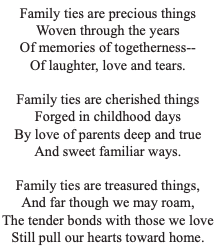
Of the original 6 Smith children, Kay Curry (94) and Anita Hilim (90) continue living in their respective Laramie homes–alone! This history is an updated version (Jan, 2020, by Darrel Curry) of the memories from the 6 children originally compiled by Florence (Smith) Atkinson in 1987, and written by Kay (Smith) Curry (2013) with inputs from Donna (Smith) Newkirk.

 Facebook
Facebook
 X
X
 Pinterest
Pinterest
 Copy Link
Copy Link

